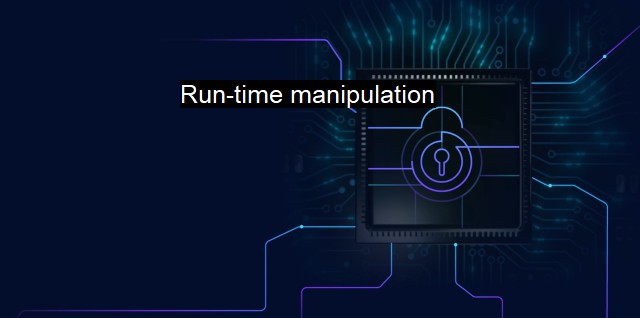What is Run-time manipulation?
Exploring the Risks and Benefits of Run-time Manipulation in Computer Programming and Cybersecurity
Run-time manipulation refers to constructs and operations that can take place while an application, software, or system is running. run-time manipulation is a topic of particular interest and importance as it involves dynamic changes to existing applications potentially changing their behavior for malicious purposes posing a threat to the stability and safety of the system.Cybersecurity is increasingly a cause for concern in a technologically dependent society. Among the numerous threats and attack methods utilized by cybercriminals, one particular area of attention is 'run-time manipulation'. This refers to alterations happening during the operation or running of an application. It goes beyond just modifying the programmable software or hardware functions at their source. Instead, it involves adjunctive manipulation occurring during an active process, typically without initial detection. This can result in the software behaving undesirably, often leading to disruptions, data theft, or network breaches.
While the technique can prove useful for developers, performance tuners, and systems administrators, run-time manipulation can also be exploited by hackers or cybercriminals to penetrate the defenses of targeted software or applications during their operation. With run-time manipulation, such intruders can perform actions such as data tampering, process hijacking, or memory content alteration, thus facilitating unauthorized access and control. Primarily, this is carried out through methods such as debuggers, infectors or interpreters that surreptitiously inject malicious code into the running software.
A common method of execution for run-time manipulation is known as dynamic injection, often taking the form of buffer overflows, heap exploits, or vulnerabilities within specific code. Internet-facing applications are particularly at risk due to their inherent connectivity and interactive nature, with the menial task escalation potentially being manipulated at run-time to carry out nefarious activities.
The significant risks to data and system security inherent in run-time manipulation have led to the proliferation of a variety of antivirus measures designed to counteract these threats. An antivirus software essentially intervenes and takes protective measures to halt such unauthorized accesses.
A critical role of an antivirus in preventing run-time manipulation is its ability to conduct continuous system surveillance and real-time scanning. Antivirus software can quickly isolate suspicious activities and actions, identify a run-time manipulation intrusion, and limit or repair any damage incurred.
Antivirus applications frequently utilize heuristic analysis, allowing them to detect previously novel threats or unknown run-time manipulations. Heuristics allows the investigation of potential threats and applications by identifying common characteristics or behaviours, determining the likelihood of being malicious or benign. This proactive approach enables antivirus software to stay one step ahead and deter threats before they run rampant within the system.
Many developed antivirus softwares now also take advantage of artificial intelligence (AI) and machine learning algorithms. These are mechanisms that continually learn known harmful data patterns and corresponding intrusive programs, which help in reducing the rate of false positives and increase the efficiency of malicious programming detection at run-time.
Run-time manipulation is a sophisticated technique utilized primarily by cybercriminals which, if unchecked, can lead to severe damage to system stability and data safety. with comprehensive antivirus mechanisms mediating the execution of such threats through active monitoring and heuristic structures, along with AI and machine learning algorithms, successful exploitation of system vulnerabilities through run-time manipulation can, to a significant degree, be curbed and controlled. Given the severe implications and potential financial loss that can occur as a result of a successful attack, protection against run-time manipulation should be a priority for any system or organization.

Run-time manipulation FAQs
What is run-time manipulation in the context of cybersecurity and antivirus?
Run-time manipulation refers to the act of modifying a program's behavior or data during its execution. In the context of cybersecurity and antivirus, run-time manipulation may be used to evade detection by antivirus software and carry out malicious activities.How can run-time manipulation be detected by antivirus software?
Antivirus software may use various techniques to detect run-time manipulation, such as code analysis, behavioral analysis, and memory scanning. These techniques can help identify suspicious activities and patterns that suggest the presence of run-time manipulation.What are some examples of run-time manipulation attacks?
Some examples of run-time manipulation attacks include buffer overflow attacks, DLL injection attacks, and code injection attacks. These attacks exploit vulnerabilities in software to modify its behavior or data during runtime, potentially allowing attackers to perform unauthorized actions or steal sensitive information.How can developers prevent run-time manipulation attacks in their software?
Developers can take several steps to prevent run-time manipulation attacks, such as using secure coding practices, implementing input validation and boundary checks, and using encryption and obfuscation techniques to protect sensitive data. Regular software updates and vulnerability scans can also help identify and patch potential vulnerabilities that could be exploited by run-time manipulation attacks.| | A | | | B | | | C | | | D | | | E | | | F | | | G | | | H | | | I | | | J | | | K | | | L | | | M | |
| | N | | | O | | | P | | | Q | | | R | | | S | | | T | | | U | | | V | | | W | | | X | | | Y | | | Z | |
| | 1 | | | 2 | | | 3 | | | 4 | | | 7 | | | 8 | | |||||||